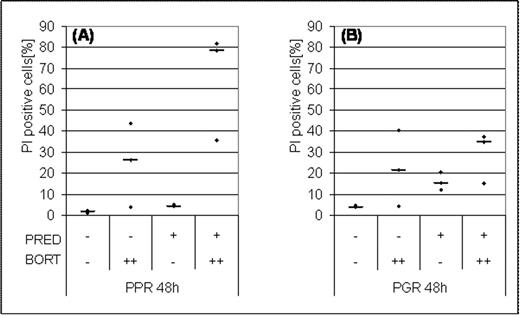Abstract
Abstract 991
Poster Board I-13
The response to initial glucocorticoid therapy in childhood acute lymphoblastic leukemia (ALL) reliably predicts the response to multi-agent chemotherapy. In a recent study, we identified the valosin-containing protein (VCP/p97), part of the ubiquitin proteasome degradation pathway (UPDP), as a differentially expressed protein in prednisone good (PGR) and poor responder (PPR) patients (Lauten et al. 2006). This may indicate that the UPDP is possibly altered and may be involved in multi-agent chemotherapy resistance in childhood ALL patients. The proteasome inhibitor bortezomib (VELCADE®, Millenium Pharmaceuticals, Cambridge, MA, USA) blocks proteasomal degradation and hence the UPDP. It may therefore be a useful tool to determine mechanistically, whether prednisone resistance is linked to ubiquitination of proteins like IkB, which can be chaperoned by VCP within the UPDP.
Thus, the aim of the study was to investigate the association of differential VCP expression and glucocorticoid response in childhood ALL cell lines in order to find ways to overcome prednisone resistance by means of proteasomal inhibition.
To investigate whether treatment of ALL with the proteasome inhibitor bortezomib acts synergistically with glucocorticoid treatment, human B-cell precursor leukemic cell lines MHH cALL 2 (PPR) and MHH cALL 3 (PGR) were treated with prednisone (6.2 μM) and various concentrations of bortezomib (1.5 nM-12 nM) for up to 96 hours. Cells were sampled every 24 h for subsequent analyses. Cell death rates were analyzed by propidium iodide (PI) and trypan blue stainings. Viability was quantified by the colorimetric WST-1 assay (11644807007, Roche). Moreover, apoptosis was determined by the Caspase-Glo 3/7® assay (G8091, Promega) and resulting data were normalized to the amount of viable cells, detected by WST-1 assay, carried out in parallel. To quantify the amount of expressed VCP and its known interaction partner IkB within the UPDP-associated NFkB pathway, real-time PCR and Western blot analysis were performed. For Western blot analyses, the mouse monoclonal anti-VCP antibody (65278, Progen) and the rabbit polyclonal anti-IkB-alpha (9242, Cell Signaling Technology) were used.
Both cell lines showed a dose-dependent increase in apoptosis after bortezomib single treatment. Single therapy with 12 nM bortezomib induced in PGR a 42-fold and in PPR cells a 29-fold higher caspase activity compared to treatment with prednisone alone. But only the PGR cells showed an additive effect on apoptosis induction after combined treatment with prednisone and bortezomib. In the PPR cell line, the amount of PI-positive, lethal cells increased within 48 hours to 20-fold after combined treatment, using 7 nM bortezomib, compared to single prednisone and 3-fold compared to single bortezomib treatment. In contrast, apoptosis was reduced compared to bortezomib single treatment. Prednisone treatment induced an increased IkB and VCP expression predominantly in PPR, with a maximum at 48 and 96h, respectively. IkB expression increased to 2-fold within 24 hours in PGR cells, whereas it increased to 3.4-fold within 48 hours in PPR cells. VCP levels were only elevated in PPR cells to about 2-fold, whereas in PGR cells the amount remained largely unchanged. In agreement with the bortezomib-induced rise in caspase activity in PPR cells, the expression profiles of the target genes VCP and IkB were modified to levels comparable to those found in PGR cells after prednisone treatment.
The altered VCP and IkB expression patterns indicate that the glucocorticoid-induced apoptosis mechanisms, mediated by the proteasomal NfkB pathway, are deregulated in prednisone resistant cells.
The results of this study suggest that VCP expression modulates prednisone response in childhood ALL. In addition, proteasome inhibitors like bortezomib seem to be able to sensitize glucocorticoid-resistant childhood ALL cells for prednisone treatment. Therefore, drug targeting the proteasome may be a novel therapeutic option in resistant ALL.
Increase of PI-positive cells in human B-cell precursor ALL cell lines, 48 hours after induction, (A) Prednisone poor responder (B) Prednisone good responder, n=3. Drug concentrations: 6.2 μM prednisone (PRED + ), 7 nM bortezomib (BORT ++ ).
Increase of PI-positive cells in human B-cell precursor ALL cell lines, 48 hours after induction, (A) Prednisone poor responder (B) Prednisone good responder, n=3. Drug concentrations: 6.2 μM prednisone (PRED + ), 7 nM bortezomib (BORT ++ ).
No relevant conflicts of interest to declare.
Author notes
Asterisk with author names denotes non-ASH members.


